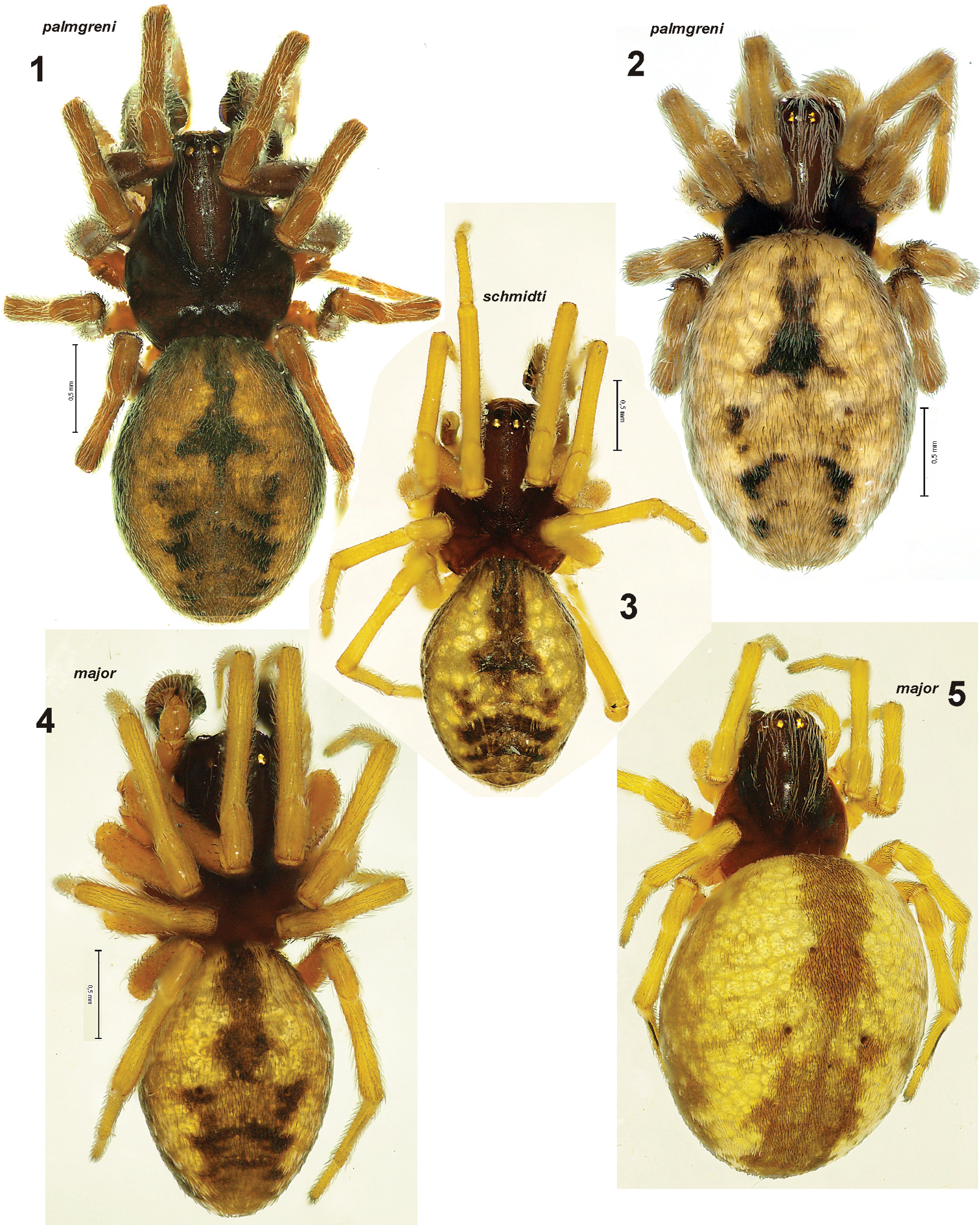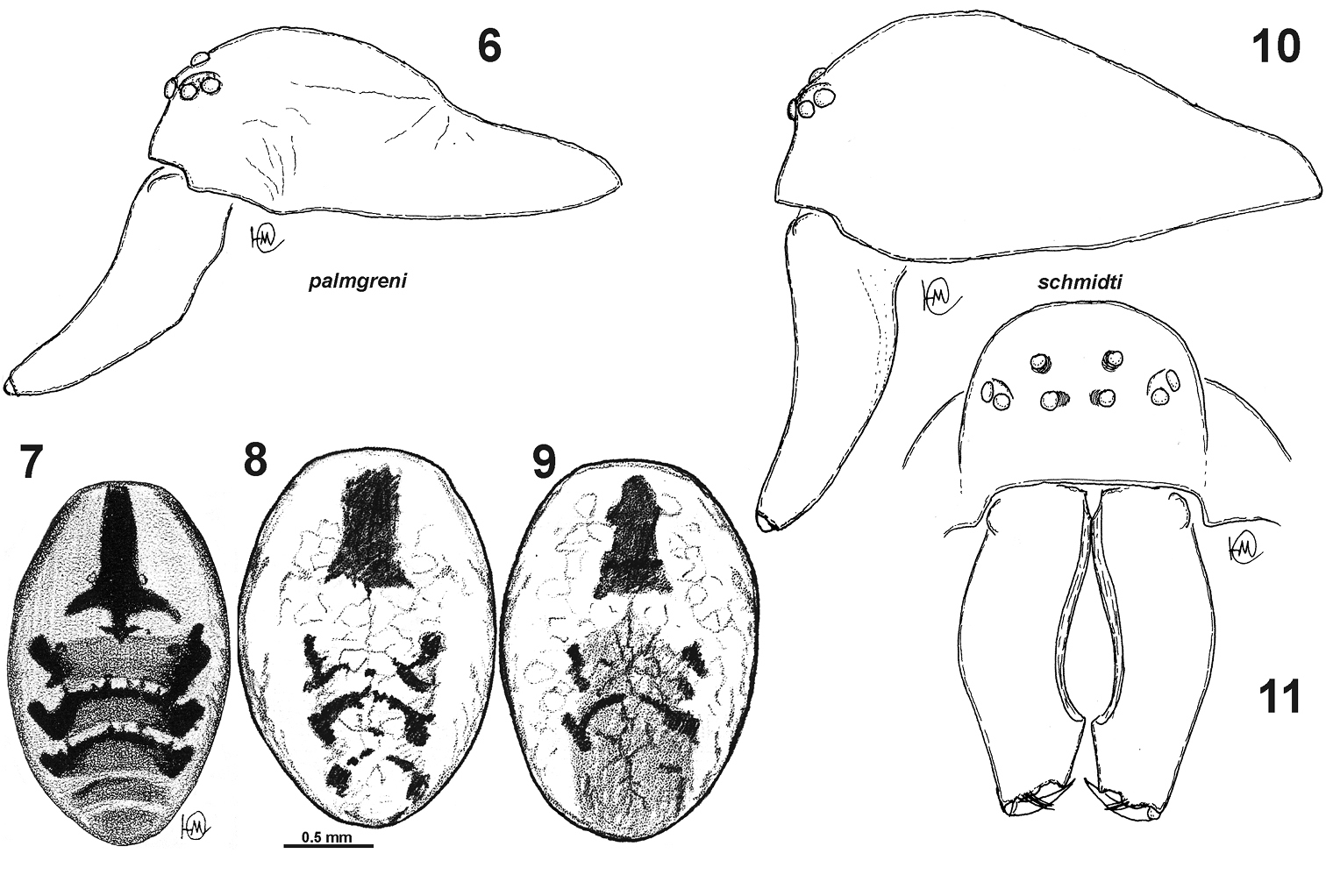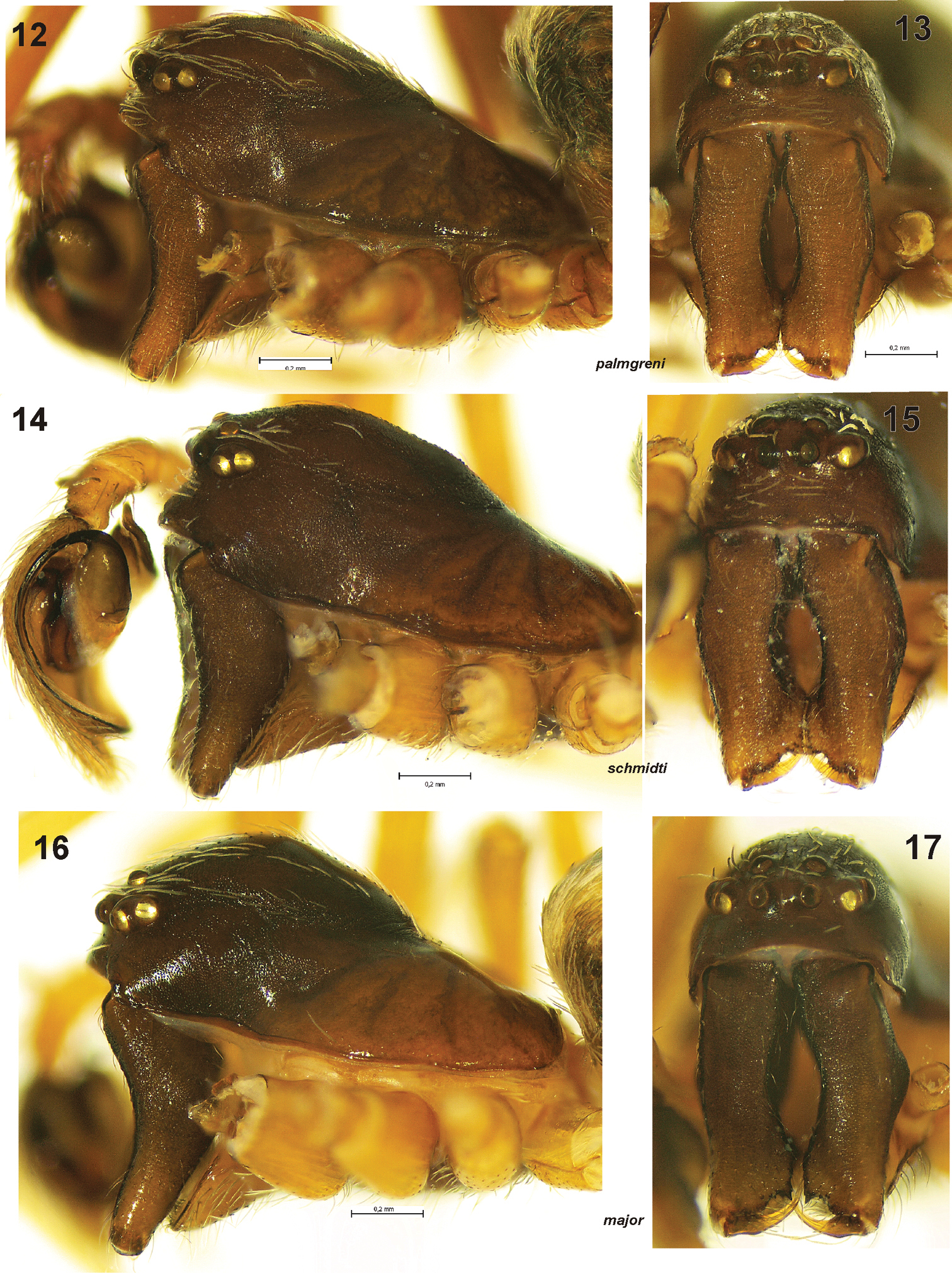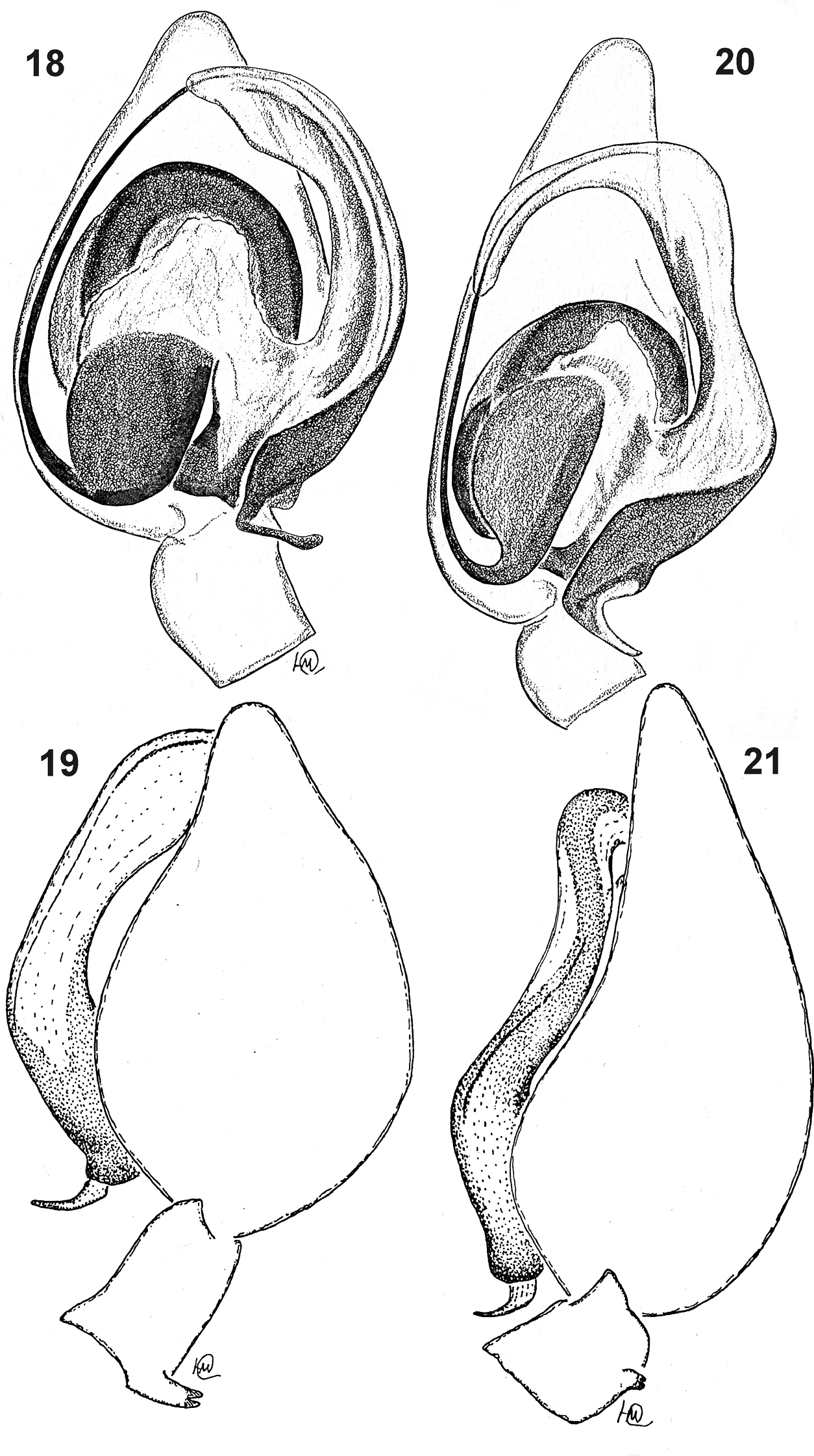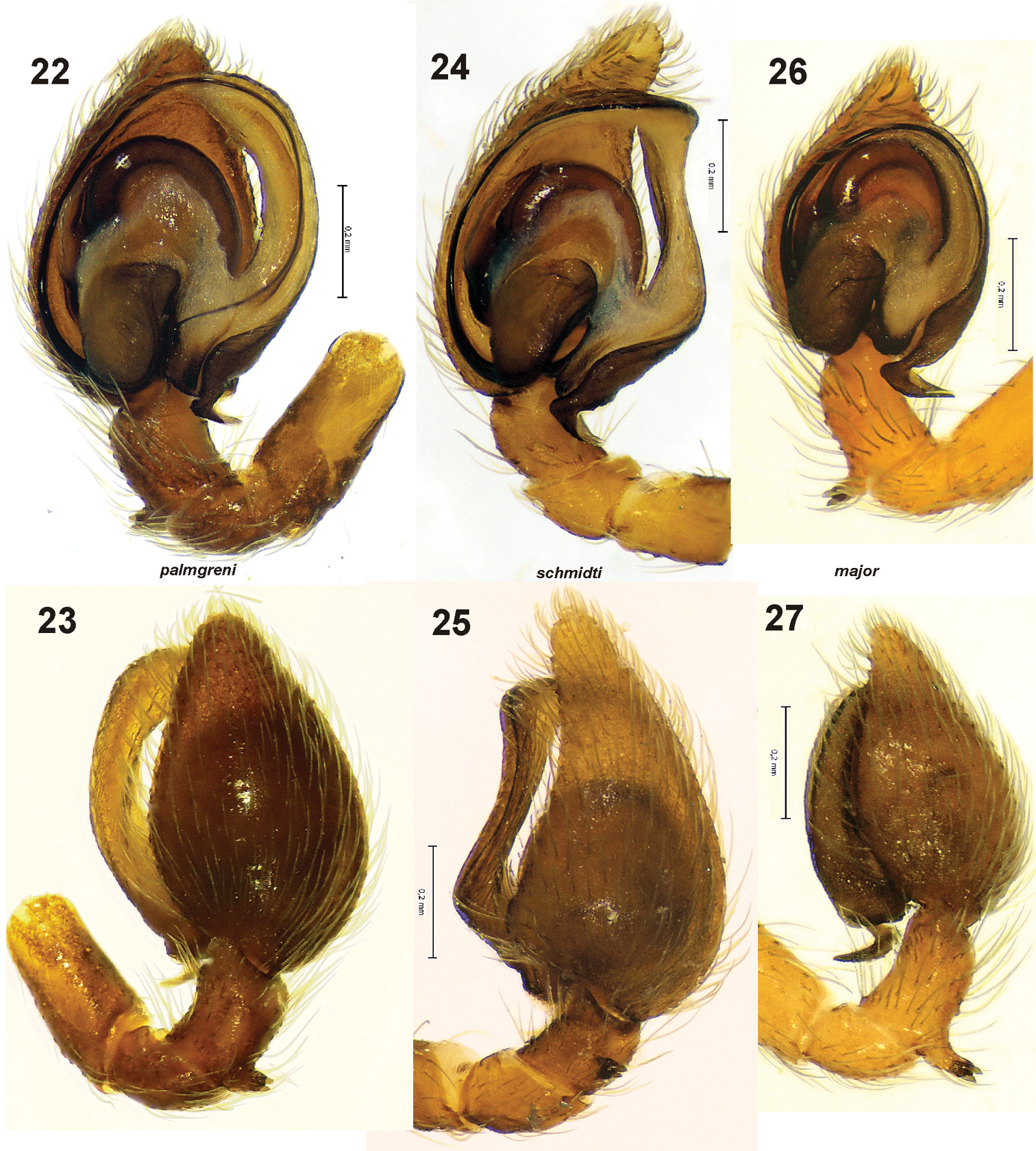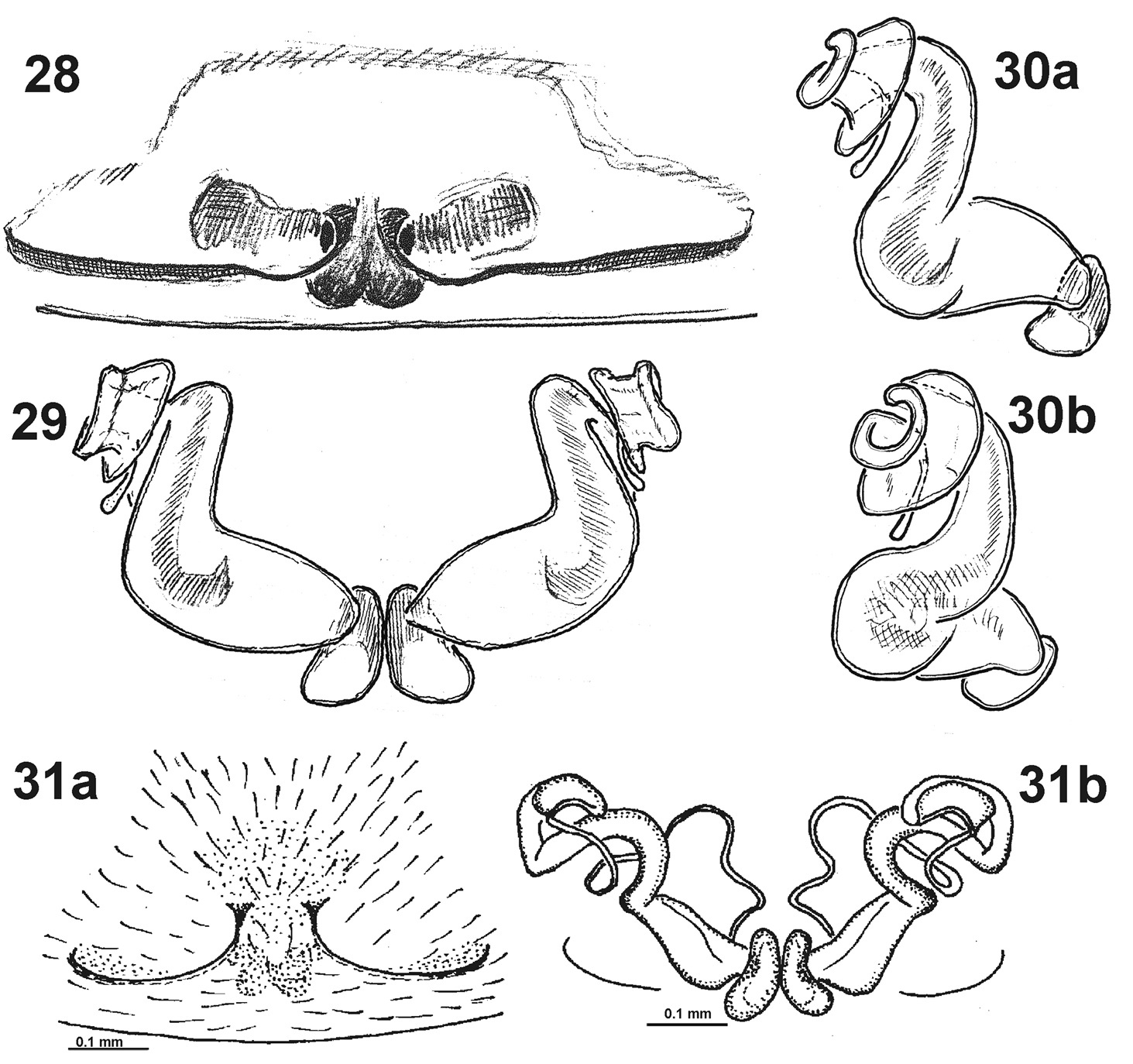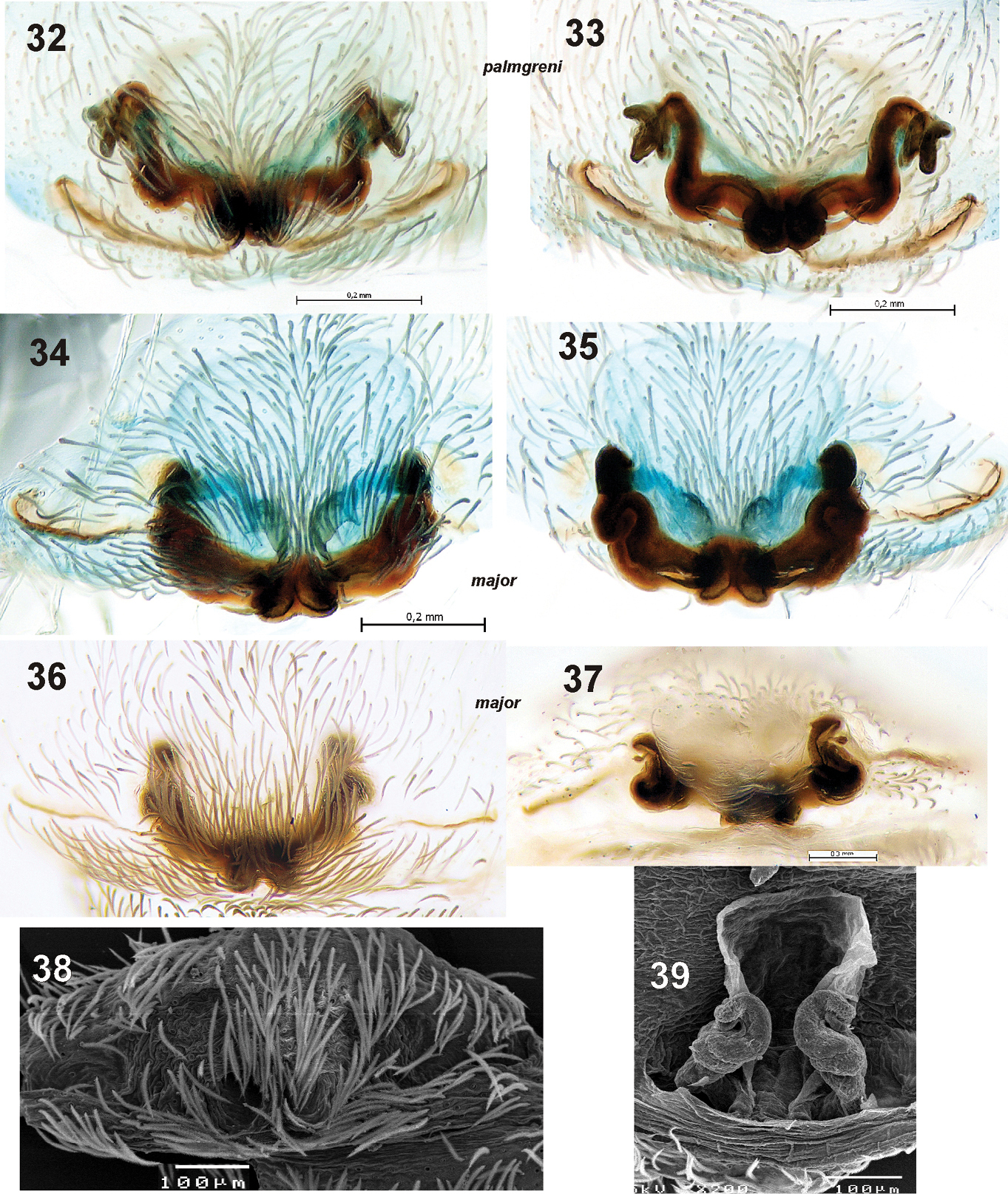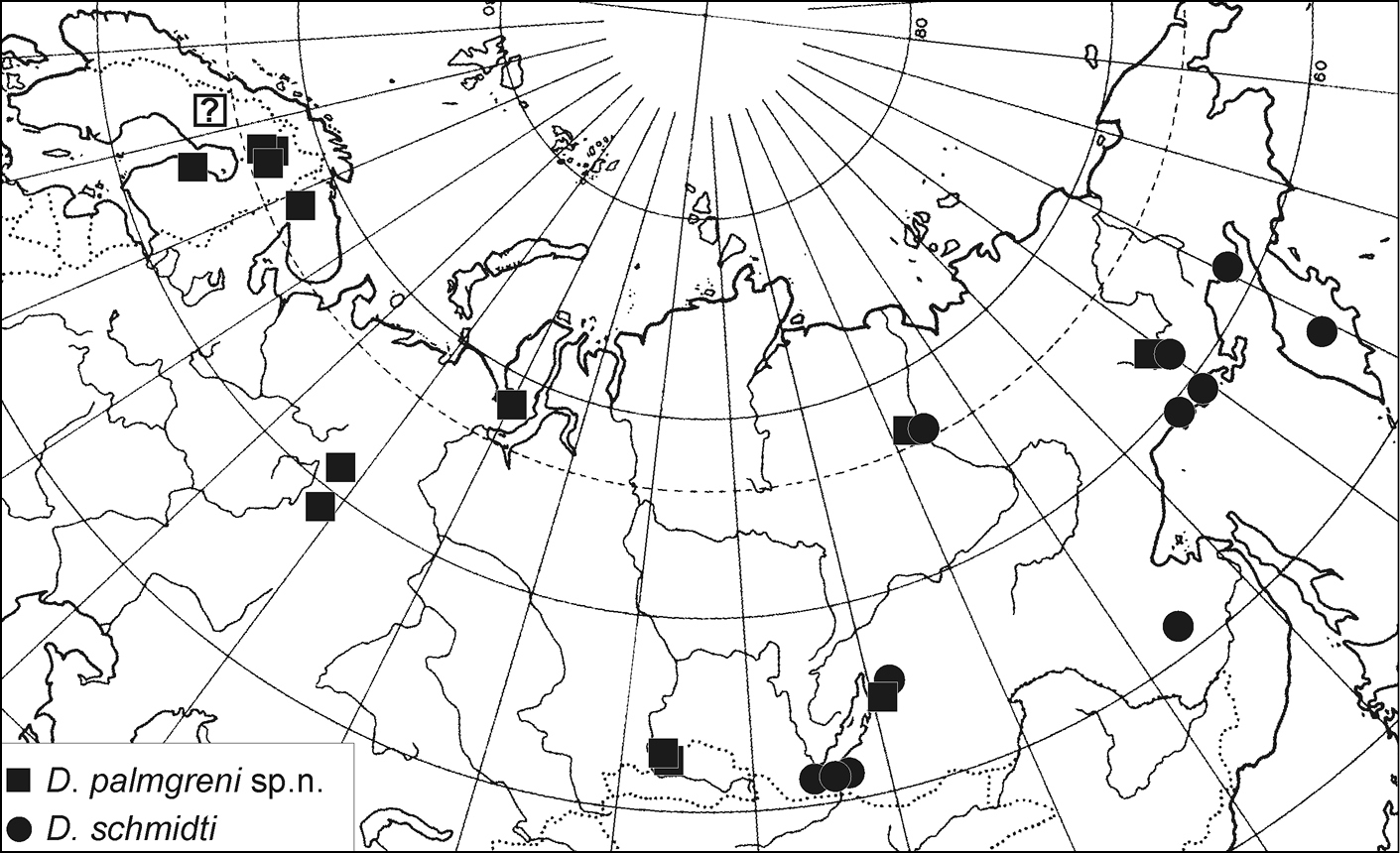






(C) 2011 Yuri M. Marusik. This is an open access article distributed under the terms of the Creative Commons Attribution License, which permits unrestricted use, distribution, and reproduction in any medium, provided the original author and source are credited.
For reference, use of the paginated PDF or printed version of this article is recommended.
A new species, Dictyna palmgreni sp. n., is described from Finland and Russia on the basis of both sexes. Most of the earlier records of Dictyna schmidti Kulczyński, 1926 from the northern Palaearctic refer to this new species. Dictyna shilenkovi Danilov, 2000, syn. n. from Cisbaikalia is synonymised with Dictyna schmidti. The general appearances and copulatory organs of Dictyna palmgreni sp. n., Dictyna schmidti and Dictyna major Menge, 1869 are illustrated. The distribution of Dictyna palmgreni sp. n. andDictyna schmidti is clarified. An unknown sac-like structure of the spermathecae of Dictyninae is briefly discussed.
spiders, Siberia, Palaearctic, Russia, Finland, epigyne, receptaculum
Dictynidae is a globally distributed medium-sized family with 566 chiefly cribellate species belonging to 50 genera (
The family, and the genus Dictyna particularly, is relatively well studied in northern Europe and Asia. Nevertheless, several species occurring in Siberia and northern Europe remain inadequately studied and are known from the original descriptions or from one sex only. The Siberian Dictynidae have been treated by (
The species Dictyna schmidti was described from Kamchatka by
Specimens were photographed using either a JEOL JSM-5200 scanning electron microscope or an Olympus E-520 camera attached to an Olympus SZX16 stereomicroscope at the Zoological Museum, University of Turku. Drawings were made either by using a grid method with a MBS-9 stereomicroscope or a Leitz stereomicroscope with a camera lucida. Macerated epigynes were temporarily coloured with Chlorazol Black to make some parts more visible. Photographs were taken with specimens in dishes with alcohol and paraffin on the bottom. Holes of different sizes were made in the paraffin to keep the specimens in the appropriate position. The epigynes were macerated either with KOH solution or lactic acid. All measurements are in mm.
Acronyms for depositories: Zoological Museum, University of Turku, Finland (ZMT); Zoological Museum, University of Helsinki, Finland (ZMH); Zoological Museum of the Moscow State University, Russia (ZMMU); Swedish Museum of Natural History, Stockholm, Sweden (NHRS); Perm State University, Russia (PSU); Institute for Biological Problems of the North, Magadan, Russia (IBPN); Institute for Systematic and Ecology of Animals, Novosibirsk, Russia (ISEA); private collection of the second author, Vasa, Finland (NRF).
Species surveyurn:lsid:zoobank.org:act:EE0F36A3-845C-4667-A447-84C10B75AF2F
http://species-id.net/wiki/Dictyna_palmgreni
Figs 1–2, 6–9, 12–13, 18–19, 22–23, 28–30, 32–33, 40Dictyna cf. major:
Dictyna sp.:
Dictyna schmidti (sensu Palmgren): Esyunin & Efimik 1996: 136.
Dictyna schmidti (sensu Lehtinen):
Dictyna schmidti (sensu Lehtinen):
Dictyna cf. schmidti:
Dictyna schmidti:
The specific name is a patronym in honour of the late Prof. Pontus Palmgren (1907–1993) who made a great contribution to studies of Finnish spiders.
FINLAND: Holotype ♂ (ZMT), Muonio, Pallastunturi national park (np), SE slope of Laukukero, 68°02'53"N, 24°03'25"E, 31.05.2008, beaten from lower spruce branches at alpine tree line (N.R. Fritzén). Paratypes: 1♀ 4j (ZMT), same data as holotype; 2♂ 3♀ 9j (ZMT), Muonio, Pallastunturi np, 67°58'50"N, 24°04'23"E, 29.05.2007, spruce fen, at the border of a small open bog, beaten from lower spruce branches (N.R. Fritzén); 1♂ (ZMT), Muonio, Pallastunturi np. 67°58'47"N, 24°04'23"E, 29.05.2007, small semi open bog, sweeping (N.R. Fritzén); 2♂ 1♀ 4j (ZMT), Muonio, Pallastunturi np, SE slope of Laukukero, 68°02'52"N, 24°03'35"E, 27.05.2007, beaten from lower spruce branches near alpine tree line (N.R. Fritzén); 1♀ (ZMT/VR90), Kittilä, Alakylä, 67°21'N, 24°53'E, 17.06.1963 (P.T. Lehtinen) (referred to as allotype of Dictyna schmidti in
Dictyna palmgreni sp. n. resembles Dictyna major and Dictyna schmidti, from which it can be easily separated by the shape of the apical portion of the conductor (broadening and then abruptly tapering, not gradually tapering like in the other two species), the relatively short cymbium, the thick and spiralled epigynal ducts and also by the presence of a digitiform process (accessorial gland). In the male palp, the combination of short length and basal placement of the tibial apophysis also distinguishes it from the two other species.
Male. Total length 2.63-3.00. Carapace: 1.10-1.30 long, 0.88-0.95 wide, cephalic part 0.60 wide, clypeus 0.14, chelicerae 0.79. Abdomen 1.75 long, 1.20 wide. Cymbium 0.69-0.79 long, 0.40-0.43 wide, length/width ratio 1.70-1.80. Leg I segments: femur 1.17, patella+tibia 1.36, metatarsus 0.86, tarsus 0.57. Carapace brown, cephalic part raised, well separated from thoracic part by ‘furrow’, cephalic portion with 5 longitudinal ‘furrows’ with sparse whitish hairs, thoracic part with radial stripes. Abdomen light to dark brown with dark grey-brownish pattern (Figs 1, 7), somewhat variable and sometimes with cardiac mark posteriorly trifid. Palp as in Figs 18-19, 22-23, tibia short, apophysis carrying ctenidia short (about 2 lengths of ctenidia) and positioned near base of tibia; conductor in one plain, upper arm of conductor abruptly cut, lower arm with bent thin tip directed retrolaterad.
Female. Total length 2.90-3.10. Carapace: 1.05-1.18 long, 0.91-0.94 wide, brown with dark-grey radial stripes, and light brown median band (behind posterior eye row). Cephalic portion with 5 longitudinal ‘furrows’ densely covered with whitish hairs. Clypeus 0.13, chelicerae 0.60. Leg I segments: femur 1.07, patella+tibia 1.14, metatarsus 0.69, tarsus 0.50. Abdomen light brownish with brown pattern as in Figs 2, 8-9, usually with cardiac mark posteriorly distinctly trifid, venter with median dark band. Epigyne as in Figs 28-30, 32-33 with thin septum and rather long margins. Vulvae with spiralled insemination ducts terminated by spiralled ‘receptacula’. ‘Receptacula’ with digitiform cylindrical accessorial gland.
Habitus of Dictyna palmgreni sp. n. 1–2 from Pallastunturi, Dictyna schmidti 3 from Yakutia and Dictyna major 4–5 from Pyhtää. 1, 3–4 male; 2, 5 female.
Prosoma and abdomen of Dictyna palmgreni sp. n. 6–9 and Dictyna schmidti 10–11. 6, 10 – male carapace, lateral 7 male abdomen, dorsal 8–9 female abdomen, dorsal 11 prosoma, frontal 6 10–11 from the Upper Kolyma 7 from Krasnoyarsk Province 8–9 from Basegi (Ural).
Male prosoma of Dictyna palmgreni sp. n. 12–13 from Pallastunturi, Dictyna schmidti 14–15 from Yakutia and Dictyna major 16–17 from Pyhtää 12, 14, 16 lateral 13, 15, 17 frontal.
Male palp of Dictyna palmgreni sp. n. 18–19 and Dictyna schmidti 20–21 from the Upper Kolyma 18, 20 ventral 19, 21 retrolateral.
Male palp of Dictyna palmgreni sp. n. 22–23 from Pallastunturi, Dictyna schmidti 24–25 from Yakutia and Dictyna major 26–27 from Pyhtää 22, 24, 26 ventral 23, 25, 27 retrolateral.
Epigyne of Dictyna palmgreni sp. n. 28–30 from Basegi (Ural) and Dictyna schmidti 31. 28, 31a epigyne, ventral 29, 31b sclerotised part of receptacula 30a, b left receptaculum, different aspects. 31 after
Epigyne of Dictyna palmgreni sp. n. 32–33 from Pallastunturi and Dictyna major 34–39 from Pyhtää 32, 34, 36, 38 macerated epigyne, ventral 33, 35, 39 macerated epigyne, dorsal 37 macerated epigyne showing sac-like structure, frontal. Sac-like structure on Fig. 39 collapsed and sclerotised parts of epigyne became closer.
Distribution map of Dictyna palmgreni sp. n. (square) and Dictyna schmidti (dot).
The new species is known across almost the entire northern Palaearctic: from Fennoscandia to Magadan, north to 68° in Finland, and southward to about 53° in Krasnoyarsk Province of Russia. To date, there have apparently been no documented adult specimens from Sweden (L. Jonsson & R. Pettersson pers. comm.), which are needed for the confirmation of its occurrence there.
Adult females occur from late May throughout the summer, males from late May to at least the beginning of July. Finnish specimens have mainly been collected from stands dominated by Norway spruce (Picea abies), and often on moist ground (swampy forest or mires). At least to some extent the species is arboreal, but some specimens have been caught using pitfall-traps and some apparently live in open habitats.
http://species-id.net/wiki/Dictyna_schmidti
Figs 3, 10–11, 14–15, 20–21, 24–25, 31, 40Dictyna schmidti:
Dictyna schmidti:
Dictyna schmidti:
Dictyna shilenkovi:
The ♂ holotype from Klutschevskoje, Kamchatka retained in the Institute of Zoology PAN (Warsaw, Poland) has not been found. The ♂ holotype of Dictyna shilenkovi and two ♀ paratypes indicated as being deposited in the Zoological Museum of the Moscow State University (see
RUSSIA: Yakutia: 1♂ (IBPN), c. 10 km downstream of Zhigansk, mouth of Ynyr Khaya Spring, 4-8.07.1989 (K.Yu. Eskov). Magadan Area: 1♂, 50 km N of Magadan, Khasyn River valley near Splavnaya Village, 28.05.1988 (Yu.M. Marusik & S.A. Ryabukhin); 1♂ (IBPN), upper Kolyma River flow, Sibit Tyellakh River basin, Olen‘ River valley, environs of “Aborigen” Field Station, around ice field, sweeping grass near alder stand, h 650m, 27.07.1987 (Yu.M. Marusik); 1♂ (IBPN), 180 km W of Magadan, Cholomdzha River middle flow, 1988 (N.Y. Dokuchaev); 1♂, Taigonos Peninsula, Paren‘ River middle flow, 07.1985 (A. Meshcheryakov).
Male. For details see
Female. Described by
This species is known from East Siberia only (Fig. 40): from Transbaikalia, northward to Zhigansk, southward to Ulan-Ude (Buryatia) and Bureinski Reserve (Khabarovsk Province) and eastward to Kamchatka.
One specimen was collected by sweeping grasses on a north exposed slope in the Upper Kolyma. One male near Magadan was found under stones. The type specimens of Dictyna shilenkovi were mainly collected from mixed forests (
http://species-id.net/wiki/Dictyna_major
Figs 4–5, 16–17, 26–27, 34–39FINLAND: 1♂ 8♀ 1j (NRF), Pyhtää, Kaunissaari 60°21'42"N, 26°46'50"E, dune shore with sparse Leymus arenarius, 9.06.2009 (N.R. Fritzén); 1♂ (NRF), Lohtaja, Vattajanniemi 64°00'34"N, 23°23'26"E, in vegetation on dune shore, 7.06.2010 (N.R. Fritzén); 1♂ Kalajoki, Letto 64°17'02"N, 23°52'32"E, dune shore with sparse vegetation, 8.06.2010 (N.R.Fritzén); 1♂ 1♀ (ZMT) Utsjoki, Lohva, 12.07.1962 (P.T. Lehtinen). CANADA: Yukon Territory: 3♂ 4♀ (IBPN) Kluane Lake, environs of research station, south bank of the lake, 5-11.07.1993 (Yu.M.Marusik); 1♀ (IBPN) environs of Carmacks, 135º55'W, 62º04'N, steppe slope and surroundings, 18.07.1993 (Yu.M.Marusik).
Numerous specimens from Tuva (
It has not been possible to trace the Finnish specimens used for making the figures of Dictyna schmidti in
Thoroughly described by
The species has a circum-Holarctic range and is known across the Palaearctic and Nearctic Regions.
This species has different habitat preferences in Siberia and in Finland. In Magadan Area, it is the most common dictynid species, occurring in various habitats within the forest belt and is most numerous on Ledum shrubs. In Finland, Dictyna major is rare, has a scattered distribution and occurs exclusively on dune shores.
Studying the relationships between Dictyna and the related Emblyna Chamberlin, 1948 faces certain difficulties. Both genera are species diverse, especially in the Nearctic, and their proper revisions in the Holarctic are lacking. Besides, data on the internal structure of the epigyne of the majority of Nearctic species is also lacking. Although males of the three species Dictyna major, Dictyna palmgreni sp. n. and Dictyna schmidti have similar palps, it is not clear whether they are related or not. The epigynes of these species are rather different. The copulatory openings of Dictyna major and Dictyna palmgreni sp. n. are similar, but those of Dictyna palmgreni sp. n. have a unique digitiform process of receptaculum which is absent in other Dictyna species known to us. The epigyne of Dictyna schmidti differs significantly from both Dictyna major and Dictyna palmgreni sp. n. The male palp of Dictyna schmidti and Dictyna szaboi Chyzer, 1891 1891 (cf.
While studying the epigynes of Dictyna palmgreni sp. n., Dictyna major and some other Dictyna and Ajmonia species we have found large transparent sac-like structures (cf. Figs 32-35, 37, 39; Figs. 5, 21 in
We want to thank the following persons for loans and various kinds of help: Seppo Koponen (ZMT), Timo Pajunen (ZMH), Heikki Hippa (NHRS), Kirill Eskov (Moscow), Torbjörn Kronestedt (NHRS), Laimonas Trilikauskas (Novosibirsk), and Terecia Fritzén for proof-reading the English of the earlier draft. English of the final draft was checked by Donald Buckle (Saskatoon, Canada). This work was supported in part by the RFFI grants # 09-04-01365 and 11-04-01716-a.
